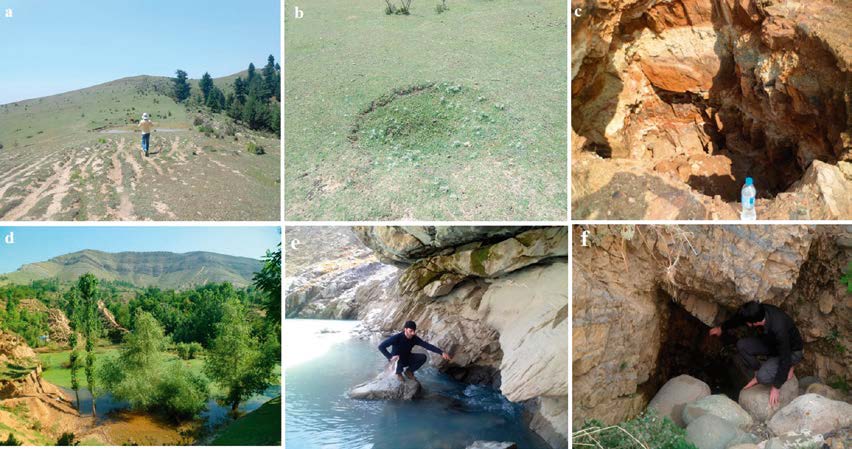Karst geomorphology, cave development and hydrogeology in the Kashmir valley, Western Himalaya, India
DOI:
https://doi.org/10.3986/ac.v47i1.5178Ključne besede:
triasni apnenec, zakrasevanje, oskrba z vodo, Himalaja, dolina KašmirPovzetek
Surface and underground karst features, such as karren, dolines, sinking streams, caves and large freshwater and thermal springs are developed in Triassic Limestone in the southern Kashmir Valley. The rock formation has a high hydraulic conductivity (K), up to 1,000 m d-1 and constitutes one of the most productive aquifers in the region. Springs discharging from this aquifer supply pristine water to more than one million people, but the regional karst system is still poorly understood. The present study is really a first and preliminary study of an important but remote and previously unstudied area, with the goal to provide a first overview and inventory of karst phenomena, as a basis for more detailed (and more “scientific”) studies in the future. Results suggest that karstification is developed along tectonic joints and bedding planes. Karstification shows distinct variation with altitude and is more developed towards the valley floor. The study also revealed that erosion of the alluvium along streams pushed karstification downwards and caused drying up of formerly phreatic cave passages. Reconstruction of karst evolution on the basis of geomorphological, geological and climatic conditions of the region suggests that karstification has started during Plio-Pleistocene. The present surface and subsurface karstification is directly related to the tectono-sedimentational history of the Himalaya and the climatic conditions that prevailed after the Himalayan Orogeny.
Key words: Triassic Limestone, karstification, freshwater supply, Himalaya, Kashmir Valley.
Kraška geomorfologija, razvoj jam in hidrogeologija v Kašmirski dolini, Zahodna Himalaja, Indija
Površinske in podzemne kraške oblike, kot so škraplje, vrtače, reke ponikalnice, jame ter veliki sladkovodni in termalni izviri, so v južni Kašmirski dolini nastale v triasnih apnencih. Ti imajo visoko hidravlično prevodnost (K) do 1000 m d-1 in so med najbolj produktivnimi vodonosniki v regiji. Izviri, ki drenirajo ta vodonosnik, prispevajo neoporečno vodo več kot milijon ljudem. Kljub temu hidrogeologijo regionalnega kraškega sistema še vedno slabo razumemo. Ta študija je prva in preliminarna študija pomembnega, a oddaljenega in predhodno neraziskanega območja ter poskuša zagotoviti prvi pregled in popis kraških pojavov kot podlaga za podrobnejše (in bolj »znanstvene«) študije. Rezultati kažejo, da je zakrasevanje razvito vzdolž tektonskih prelomov in lezik. Zakrasevanje se razlikuje glede na nadmorsko višino in je bolj razvito proti dnu doline. Študija je pokazala tudi, da je erozija aluvija vzdolž vodotokov potisnila zakrasevanje v globino vodonosnika in povzročila fosilizacijo predhodno freatičnih jamskih kanalov. Rekonstrukcija kraškega razvoja na podlagi geomorfoloških, geoloških in klimatskih razmer v regiji nakazuje, da se je zakrasevanje začelo med Plio-Pleistocenom. Sedanje površinsko in podzemno zakrasevanje je neposredno povezano s tektonsko-sedimentacijsko zgodovino Himalaje in podnebnimi razmerami, ki so prevladovale po himalajski orogenezi.
Ključne besede: triasni apnenec, zakrasevanje, oskrba z vodo, Himalaja, dolina Kašmir.
Prenosi

Prenosi
Objavljeno
Kako citirati
Številka
Rubrike
Licenca
Avtorji jamčijo, da je delo njihova avtorska stvaritev, da v njem niso kršene avtorske pravice tretjih oseb ali kake druge pravice. V primeru zahtevkov tretjih oseb se avtorji zavezujejo, da bodo varovali interese založnika ter da bodo povrnili morebitno škodo.
Podrobneje v rubriki: Prispevki




